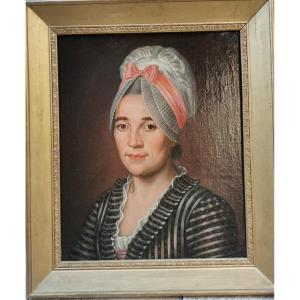Born in Scotland on 19 August 1596, Elizabeth was the only daughter of James VI of Scotland and I of England and Anne of Denmark. She was named Elizabeth in honour of the then-ageing English Queen, Elizabeth I, who had remained childless. Charles, the younger brother of his sister by four years, was perceived as feeble and improbable to live through to adulthood. Consequently, James placed his aspirations for the continuation of the dynasty and the marriages of his children in his eldest son, Henry Frederick, and his delightful daughter, Elizabeth. To all intents and purposes, Elizabeth had a happy upbringing at Linlithgow Palace, situated 15 miles west of Edinburgh, and one of the grandest of Scotland’s royal residences.
In 1603 her father James succeeded Elizabeth I to the English throne and Elizabeth went to England with her mother and older brother and thereafter grew up in the care of Lord and Lady Harington of Exton, living principally at Combe Abbey, near Coventry. In 1606, the year in which is inscribed on our portrait in the upper left, she arrived at the British royal court, where her beauty and charm attracted much attention. At the tender age of 12, Elizabeth had already gained significant political importance, attracting the attention of King Philip III of Spain, a prominent member of the influential Hapsburg family, who considered himself a suitable candidate for her hand in marriage. While Queen Anne eagerly embraced the prospect of a prestigious Spanish throne, James had his heart set on a Protestant suitor: Frederick V, Prince Palatine of the Rhine in the Holy Roman Empire, often referred to as the Palsgrave. On Valentine’s Day, 14 February 1613, Princess Elizabeth wed Frederick V in a spectacular wedding ceremony in the Royal Chapel at Whitehall Palace in London.
The 16-year-old bride was resplendent in a cloth of shimmering silver lined with taffeta. Many diamonds of estimable value were embroidered upon her sleeves which dazzled the eyes of all the beholders. She wore a crown adorned with glittering diamonds and other precious stones ‘so thick beset, that they stood like shining pinnacles, upon her amber coloured hair.’ The sixteen noble bridesmaids attending the bride were also dressed in white satin, and adorned with such a cornucopia of jewels that her passage ‘looked like a milky way’.
For almost two months, the young couple were feted and feasted in London before setting out on their journey to their new home in Heidelberg, where their first child, Frederick Henry, was born in January 1614, and later, Prince Rupert, in December 1619, the same year that Frederick and Elizabeth were crowned King and Queen of Bohemia (today part of the Czech Republic). Barely a year after receiving the crown, the couple were defeated at the Battle of the White Mountain, and driven from their court in Prague and deprived of all their Palatine lands by the Hapsburg Holy Roman Emperor Ferdinand II, events which led to one of the longest and most destructive conflicts in human history: The Thirty Years War. Elizabeth and Frederick fled, ultimately finding refuge at The Hague with Prince Maurice of Orange, where they established a court in exile, for the following 40 years, and were remembered as the ‘The Winter Queen’, a derogatory epitaph that reflects the short duration of her rule in Bohemia, with her union with Frederick deemed a political failure.
Her eldest son died in 1629, followed by her husband, unexpectedly from the plague, in 1632. Finally, in 1661, her nephew Charles II reluctantly permitted her to return to England, and she died the following year in London. Forty years after Elizabeth’s death, The Act of Settlement of 1701 named the Electress Sophia of Hanover (1630-1714), Elizabeth’s younger daughter, as the most direct Protestant heir to the English throne. Her grandson, Prince George of Hanover, would succeed to the throne in 1714 after the death of Queen Anne, the last Stuart monarch.
Robert Peake, who was born into a Lincolnshire family around 1551, first worked as an apprentice to a goldsmith in Cheapside. In 1576, after becoming a Freeman of the Goldsmith's Company, he then went on to work for the Office of the Revels. There he was one of the six ‘Paynters’ and others responsible for the preparations for the court festivities at Christmas, New Year, Twelfth-night and Candlemas in the winter of that year. Peake persisted in creating ornamental pieces for the royal court for a number of additional years until he had gained a solid reputation to establish his own studio. By 1598, as documented in Francis Mere's Palladis Tamia, he was recognised as one of the leading artists actively working in England.
Upon the accession of James I in 1603, Peake was commissioned to paint portraits of our sitter and her brother. The resulting paintings, 'Henry, Prince of Wales and his friend Sir John Harington of Exton after the hunt, and its companion, that of Princess Elizabeth, later Queen of Bohemia, were two of the most ambitious and original images yet seen in British royal portraiture.
Subsequently, as the precocious Prince's official painter, Peake produced further unparalleled works, the most notable being the remarkable and monumental equestrian portrait of 'Henry, Prince of Wales' at Parham House. In 1607, Peake was jointly appointed with John de Critz as Serjeant Painter to James I. He died in 1619.
Measurements: Height 81cm, Width 65cm framed (Height 31.75”, Width 25.5” framed)



























 Le Magazine de PROANTIC
Le Magazine de PROANTIC TRÉSORS Magazine
TRÉSORS Magazine Rivista Artiquariato
Rivista Artiquariato
